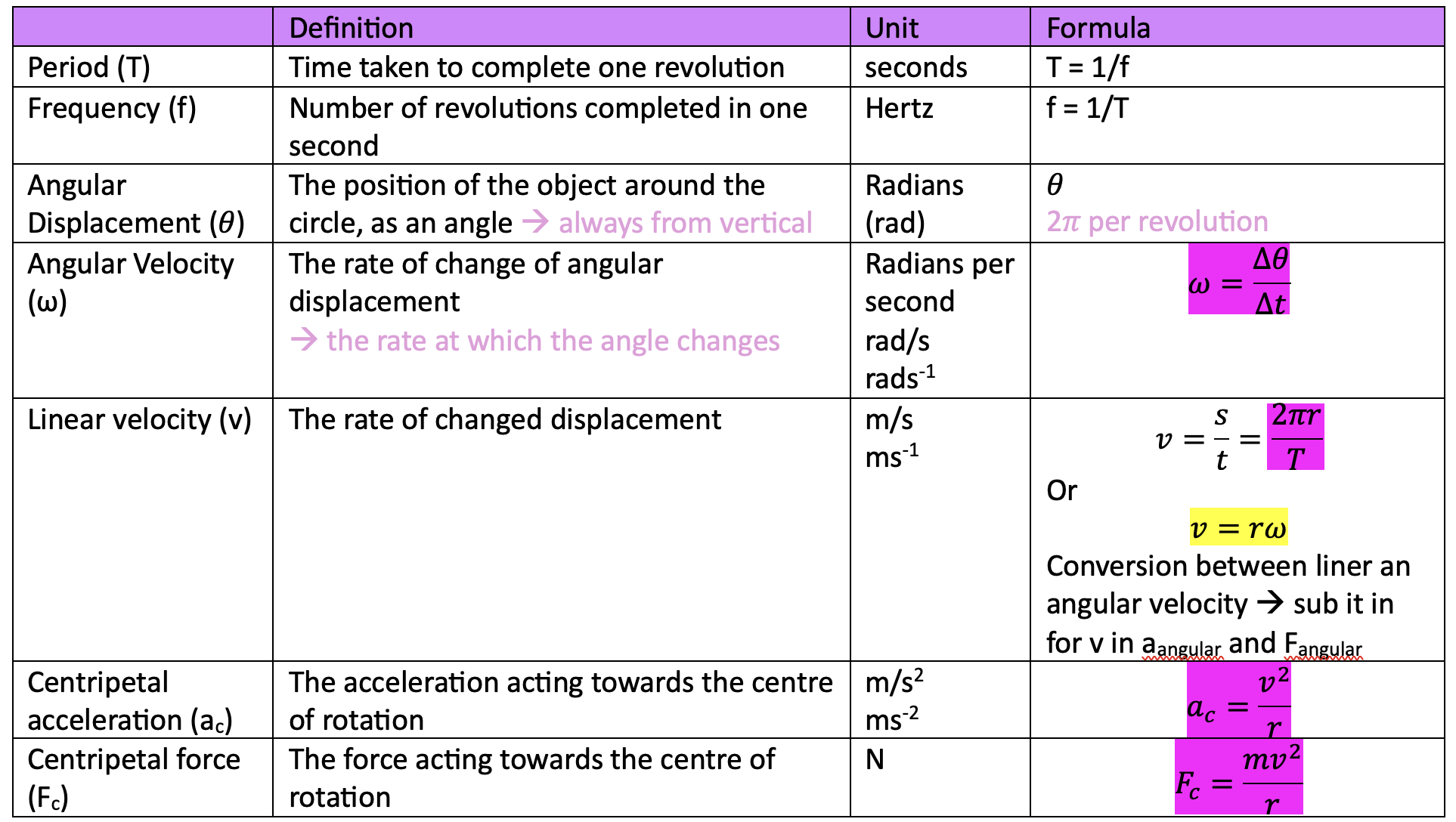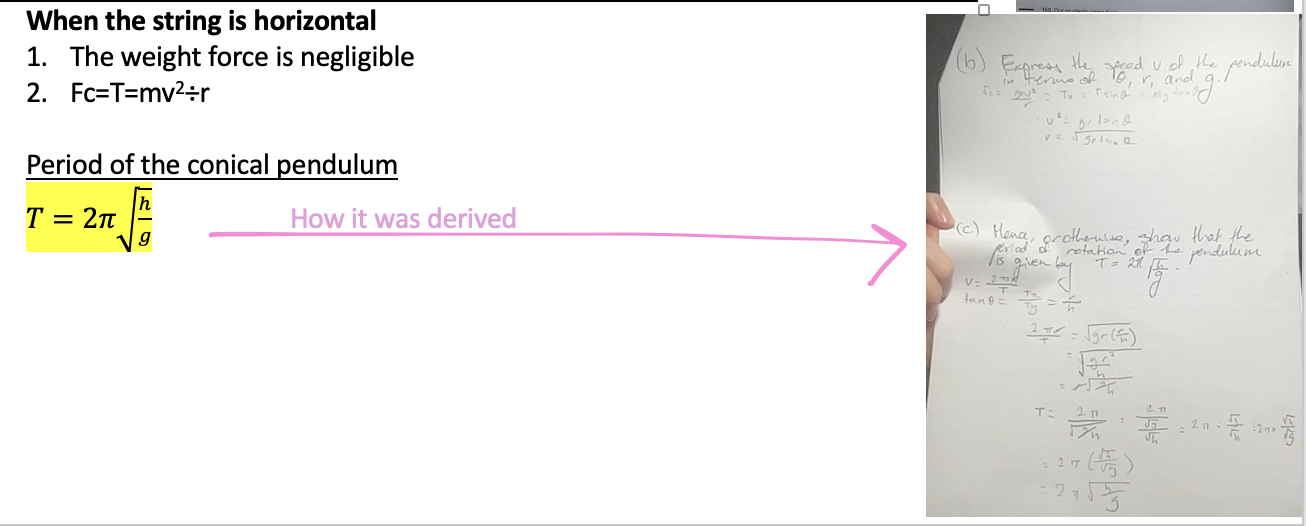Circular Motion
1/11
There's no tags or description
Looks like no tags are added yet.
Name | Mastery | Learn | Test | Matching | Spaced |
|---|
No study sessions yet.
12 Terms
how to solve for non-uniform circular motion
draw a freebody diagram + use the forces to show a net force (fnet = force up - force down). Input in these values and rearrange
top of circle on inside of rollercoaster/ at top of string:
fnet = weight + tension/normal (both down)
mv²/r=mg → v=√gr for MIN velocity at top
bottom of circle:
fnet = tension/normal - weight
top of circle on outside of rollercoaster:
fnet = weight - normal
can also use conservation of energy to find velocity in worst-case (using it with reference to the top because generally v=√gr)
real weight vs apparent weight
real weight = true weight = mg —> never changes
apparent weight is how heavy you feel based on the forces acting on you
—> weightless = you are in freefall
No acceleration
fnet = 0, you feel your real weight
Accelerating up
fnet = N - mg —> N = ma + mg, you feel heavier
Accelerating down
fnet = mg + N —> N = ma-mg, you feel lighter
Characteristics of UCM
radius is constant
period is constant
speed is same
direction if linear velocity is tangential to force
acceleration/fnet is towards the centre (centripetal) + is constant
angular velocity is constant
formula for UCM characteristics
not if F = MAc is not exact, the object will not execute UCM
F < MAc = slip out of turn
F > MAc = slip into turn
angular velocity must be in rad/s
RPM is bigger than rad/s:
RPM —> Rad/s = x (2𝜋/60)
Rads —> RPM = ÷(2𝜋/60)
for hertz:
f —> t —> 2 pie / T

relationship between variables in Fc equation

solving UCM for car on flat road
provider: friction
draw freebody diagram
mg = N
Fc = friction = 𝜇N = mv²/r
solve for unknowns
If looking for acceleration, use Fnet = ma
E.g. 𝜇N = (mv²/r ∴ v=√μgr
If looking for velocity, use Fnet = (mv²/r
E.g. a = 𝜇N ÷ m
solving UCM for car on banked road (no friction)
Provider = horizontal component of the normal force
freebody diagram
normal force
weight force
Decompose the normal force into vertical and horizontal components
Nx = Nsin𝜃, Ny = Ncos𝜃
Apply N2L
y: Fnet = 0, Ny = Ncos𝜃 = mg (eq 1)
x: Nx = Nsin𝜃 = ma (eq 2) = mgtan𝜃
Solve simeltaneously by dividing eq 2 and 1
tanW = a/g
a=v²/r=gtanθ ∴v=√grtanθ
Find the normal force
Can use pythag
N =mg/cosθ
solving UCM for car on banked road (friction)
provider: x component of normal and friction —> friction generally goes DOWN THE SLOPE
freebody diagram
normal
weight
friction
decompose normal and friction into vertical and horizontal components
y: Ncosθ = mg+Fsinθ
x: Fc = mv²/r = Nsinθ+Fcosθ
Solve simeltaneously by rearranging for m in y and substituting it in for x
rearrange for v
substitute friction in for μN so:

a mass on a string
provider: x component of tension
freebody (mg and tension)
decompose tension
a. Tx = Tsin𝜃, Ty = Tcos𝜃 → Theta is always from the vertical
Apply N2L
y: Fnet = 0, Ty = Tcos𝜃 = mg (eq 1)
x: Tx = Tsin𝜃 = ma (eq 2) = mgtan𝜃
solve simeltaneously by diving eq 2 by 1
find acceleration and velocity:

find tension
Can use pythag
T=mg/cosθ
period of a conical pendulum

work in UCM
none
No work is done when an object is in uniform circular motion (for any plane)
• Since the speed is not changing, the kinetic energy stays the same
• Since F and s are tangential (are perpendicular), work = 0
THERE IS NO WORK DONE IN A VERTICAL PLANE → BUT THE MECHANICAL ENERGY (U) IS CHANGING
torque
a measure of the force that can cause an object to rotate about an axis —> ROTATIONAL FORCE
max when r and F are perpendicular (sin90 = 1)
Torque is a vector
anticlockwise (-) and clockwise (+)
they can add
τ=r⊥ F=rF sinθ —> theta is angle between vectors
for a rigid body, torque is constant so:
τ=r1⊥ F1 =r2⊥ F2
→ solve torque by decomposing F/r to and multiply it by the perpendicular component to r/F